
Word 2010
.pdf
M O D U L A R S Y S T E M
MICROSOFT WORD 2010
Mükremin ÖZKUL
h t t p : / / b o o k . z a m b a k . c o m
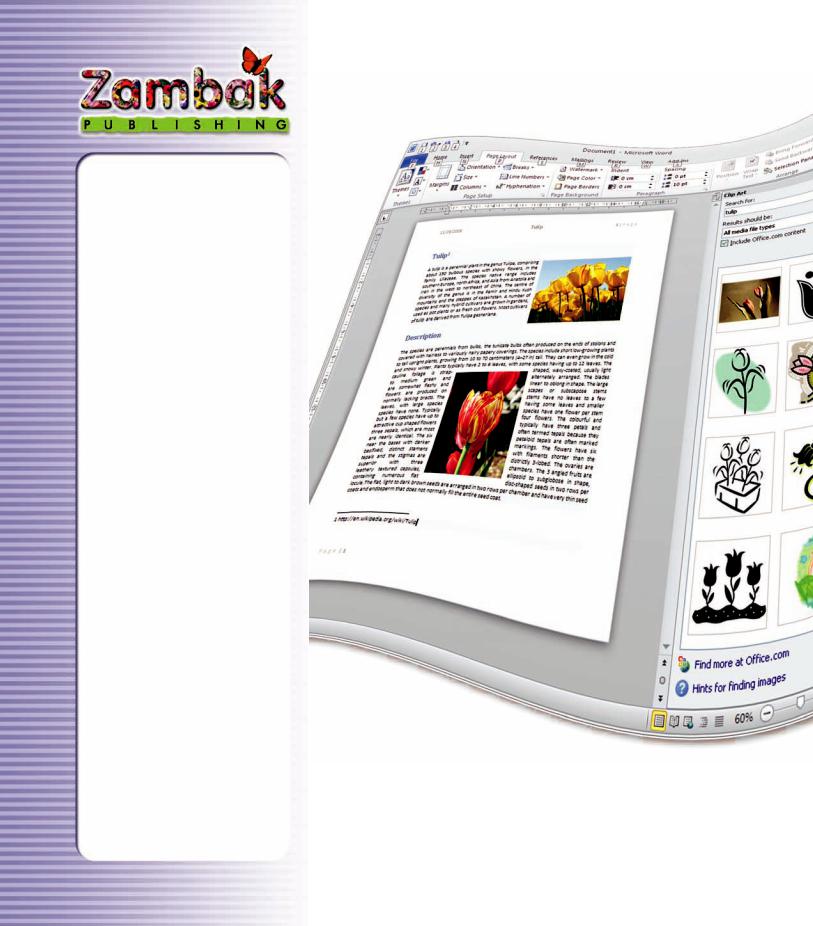
Copyright © Sürat Basým Reklamcýlýk ve Eðitim Araçlarý San. Tic. A.Þ.
All rights reserved. No part of this book may be
reproduced, stored in a retrieval system or transmitted in any form without the prior written permission of the publisher.
Digital Assembly
Zambak Typesetting & Design
Page Design
Edip TÜRK
Serdal YILDIRIM
Editor
Osman AY
Proofreader
Andy Martin
Publisher
Zambak Basým Yayýn Eðitim ve Turizm Ýþletmeleri Sanayi Ticaret A.Þ.
Printed by
Çaðlayan A.Þ. Sarnýç Yolu Üzeri No:7 Gaziemir / Izmir, March 2010 Tel: +90-0-232-252 22 85
+90-0-232-522-20-96-97
ISBN: 978-975-???-???-?
Printed in Turkey
DISTRIBUTION
ZAMBAK YAYINLARI Bulgurlu Mah. Haminne Çeþmesi Sok. No. 20 34696 Üsküdar / Istanbul
_______________________
Tel.: +90-216 522 09 00 (pbx)
Fax: +90-216 443 98 39 http://book.zambak.com
"Microsoft, MSN, Microsoft Excel 2010, Microsoft Office 2010, and Windows are either registered trademarks or trademarks of Microsoft Corporation in the United States and/or other countries."
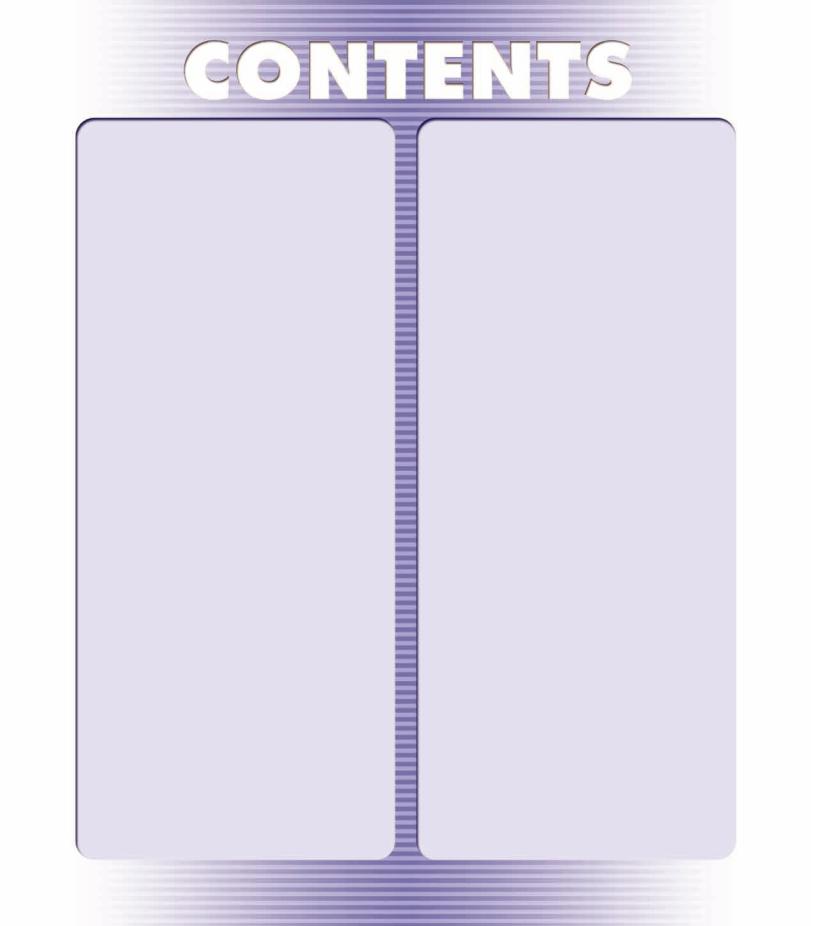
1. Getting Acquainted with Microsoft Word
Introduction . . . . . . . . . . . . . . . . . . . . . . . . 6
Uses of Word . . . . . . . . . . . . . . . . . . . . . . . 6
Creating a New . . . . . . . . . . . . . . . . . . . . . 11
Saving a Document . . . . . . . . . . . . . . . . . . 13
Opening a Document. . . . . . . . . . . . . . . . . 15
Converting a Document . . . . . . . . . . . . . . . 17
Closing a Document. . . . . . . . . . . . . . . . . . 17
Document Views. . . . . . . . . . . . . . . . . . . . . 18
Sending and Sharing Documents. . . . . . . . . 19
Getting Help . . . . . . . . . . . . . . . . . . . . . . . 19
2. Working with Text
Moving Through a Document . . . . . . . . . . . 24
Selecting Text . . . . . . . . . . . . . . . . . . . . . . . 25
Copy and Move . . . . . . . . . . . . . . . . . . . . . 26
Undo and Redo . . . . . . . . . . . . . . . . . . . . . 28
Find and Replace . . . . . . . . . . . . . . . . . . . . 28
Spelling and Grammar . . . . . . . . . . . . . . . . 29
Research Task Pane . . . . . . . . . . . . . . . . . . 30
The Thesaurus . . . . . . . . . . . . . . . . . . . . . . 31
Translating Text. . . . . . . . . . . . . . . . . . . . . . 32
Moving Through a Document . . . . . . . . . . . 24
Selecting Text . . . . . . . . . . . . . . . . . . . . . . . 25
Copy and Move . . . . . . . . . . . . . . . . . . . . . 26
Undo and Redo . . . . . . . . . . . . . . . . . . . . . 28
Find and Replace . . . . . . . . . . . . . . . . . . . . 28
Spelling and Grammar . . . . . . . . . . . . . . . . 29
Research Task Pane . . . . . . . . . . . . . . . . . . 30
The Thesaurus . . . . . . . . . . . . . . . . . . . . . . 31
Translating Text. . . . . . . . . . . . . . . . . . . . . . 32
3. Formatting Characters and Paragraphs
Font Formatting . . . . . . . . . . . . . . . . . . . . . 36
Paragraph Formatting . . . . . . . . . . . . . . . . . 39
Bulleted and Numbered Lists. . . . . . . . . . . . 43
Borders and Shading . . . . . . . . . . . . . . . . . 45
Columns . . . . . . . . . . . . . . . . . . . . . . . . . . 47
Tabs . . . . . . . . . . . . . . . . . . . . . . . . . . . . . 48
Styles. . . . . . . . . . . . . . . . . . . . . . . . . . . . . 50
4. Page Setup and Printing
Page Setup . . . . . . . . . . . . . . . . . . . . . . . . 58
Printing . . . . . . . . . . . . . . . . . . . . . . . . . . . 60
5. Inserting and Formatting Objects
Equations. . . . . . . . . . . . . . . . . . . . . . . . . . 64
Symbols. . . . . . . . . . . . . . . . . . . . . . . . . . . 65
Drop Cap Letters . . . . . . . . . . . . . . . . . . . . 66
Page Numbers . . . . . . . . . . . . . . . . . . . . . . 67
Cover Pages . . . . . . . . . . . . . . . . . . . . . . . 67
Date and Time . . . . . . . . . . . . . . . . . . . . . . 68
6. Tables
Tables . . . . . . . . . . . . . . . . . . . . . . . . . . . . 72
Table Borders. . . . . . . . . . . . . . . . . . . . . . . 74
Table Styles . . . . . . . . . . . . . . . . . . . . . . . . 74
Resizing and Moving Tables. . . . . . . . . . . . . 76
Calculating Tables . . . . . . . . . . . . . . . . . . . 77
Sorting Tables . . . . . . . . . . . . . . . . . . . . . . 78
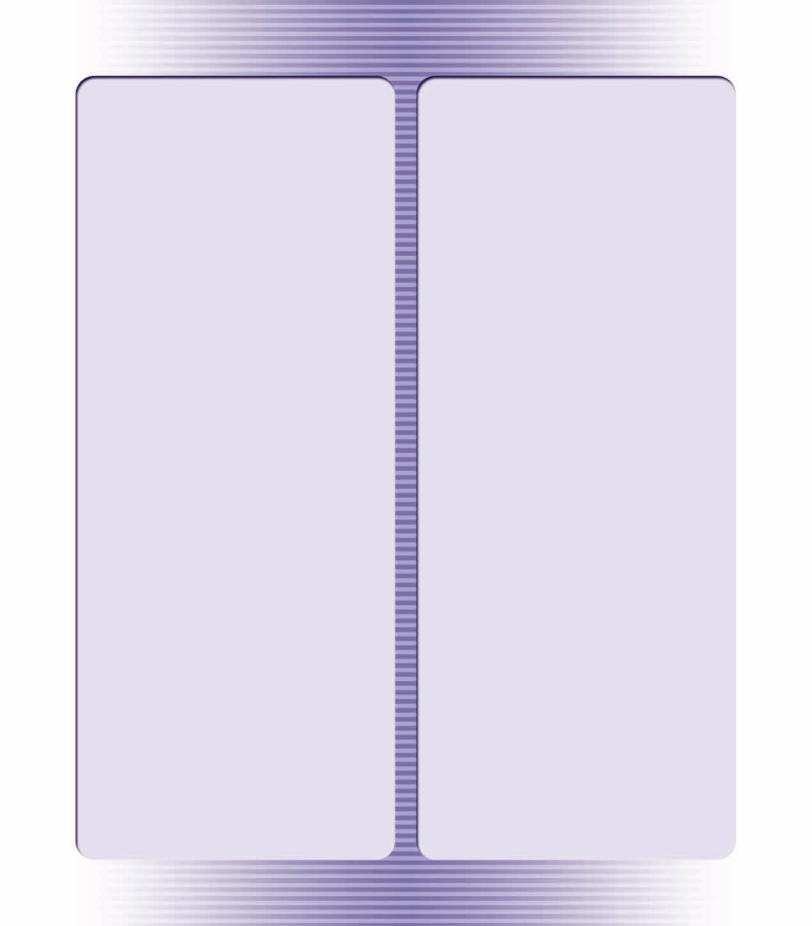
7. Pictures and Drawings
Pictures and Drawings. . . . . . . . . . . . . . . . . 82
Clip Art . . . . . . . . . . . . . . . . . . . . . . . . . . . 82
Inserting Pictures . . . . . . . . . . . . . . . . . . . . 83
Picture Adjustments. . . . . . . . . . . . . . . . . . . 84
Resizing and Cropping Pictures . . . . . . . . . . 86
Rotating and Moving Pictures . . . . . . . . . . . 87
Positioning Pictures . . . . . . . . . . . . . . . . . . . 88
Picture Styles and Effects . . . . . . . . . . . . . . . 88
Drawings . . . . . . . . . . . . . . . . . . . . . . . . . . 89
8. Charts and SmartArt Graphics
Charts . . . . . . . . . . . . . . . . . . . . . . . . . . . . 96
Chart Layouts and Formats . . . . . . . . . . . . . 98
SmartArt Graphics . . . . . . . . . . . . . . . . . . . 99
WordArt . . . . . . . . . . . . . . . . . . . . . . . . . . 100
Text Boxes. . . . . . . . . . . . . . . . . . . . . . . . . 102
9. Working with Long Documents
Headers and Footers . . . . . . . . . . . . . . . . . 106
Footnotes and Endnotes. . . . . . . . . . . . . . . 107
Breaks . . . . . . . . . . . . . . . . . . . . . . . . . . . 108
Hyperlinks and Bookmarks. . . . . . . . . . . . . 109
Making Comments . . . . . . . . . . . . . . . . . . 110
Tracking Document Changes . . . . . . . . . . . 110
Mail Merge. . . . . . . . . . . . . . . . . . . . . . . . 112
10. Customizing Word and Securing Documents
Customizing Word . . . . . . . . . . . . . . . . . . 120
Securing Documents . . . . . . . . . . . . . . . . . 122
Mail Merge. . . . . . . . . . . . . . . . . . . . . . . . 127
Index . . . . . . . . . . . . . . . . . . . . . . . . . . . . 128
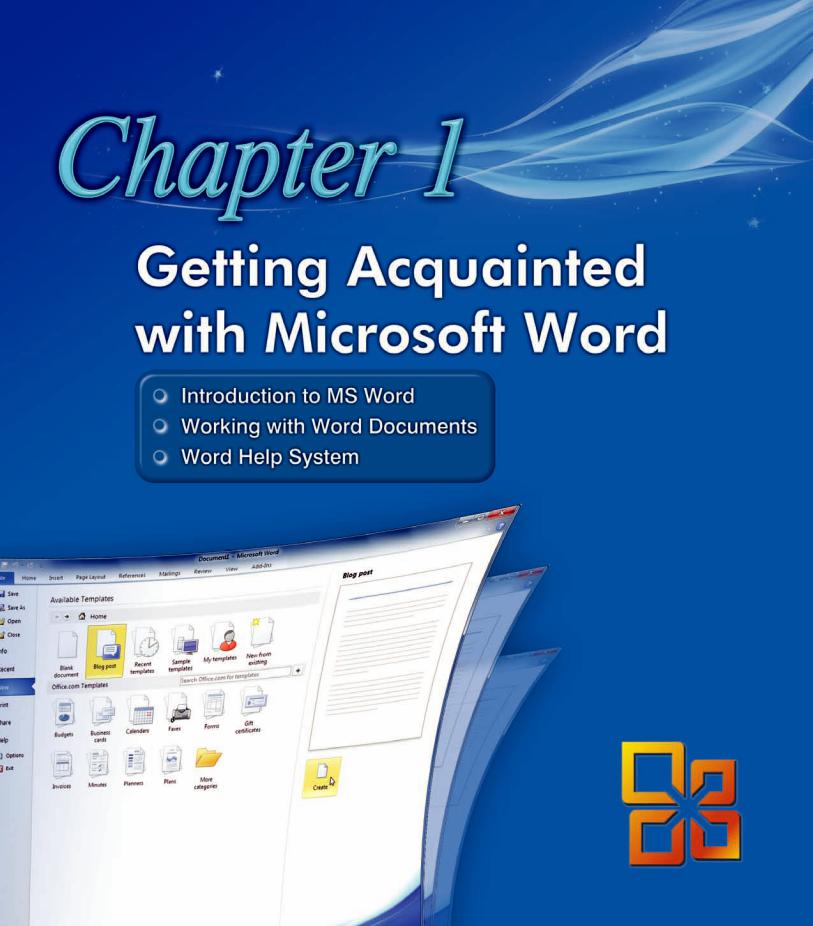

Introduction
Microsoft Word is a word-processor software that lets you create a variety of different documents such as letters, single-file reports, multifile reports, books, brochures, newsletters, and Web pages.
Word processing software lets you create, edit, format, store, retrieve, and print a text document. Creating is writing and composing the document. Editing refers to making changes to the document to fix errors or improve it. Formatting is making the document look attractive. Storing means saving it on a disk. Retrieving is opening the saved document from a disk into the computer memory. Printing is producing the document on paper, using a printer connected to the computer.
Microsoft Word provides powerful and easy-to-use tools. A few of its capabilities are: checking and correcting, spelling, and grammar, handling page organization such as page numbers, headers and footers, having auto texts, symbols and clipart, working with tables, and formatting text by one button clicking.
Uses of Word
Microsoft Word can be used at home, at school, and at work. At home, one can write notes, memos, letters, labels, envelopes, create cards, stickers or flyers. In schools, Word may be used for writing homework, theses, research notes, time tables or certificates. People working in business may use Word to set up faxes, reports, contracts, business cards or mail merge documents. It is also easy to prepare a resume or CV using Word.
Word can create complex or specialized documents that are normally created by more specialized software applications such as:
Web pages: Word has Web publishing features that let you create beginner level simple Web pages with ease.
Brochures, newsletters, and other documents with complex page layouts: Microsoft Publisher might be able to do a better job at creating short, layout-intensive documents. However, Word's improved drawing and layout features make it a highly viable tool for creating these kinds of documents.
Printer-ready publications: Dedicated desktop publishing packages (such as Adobe InDesign, or Quark Press) do a superb job of creating printer-ready publications with precise page layouts, cross-references, indexes, tables of contents, and so on. Word is ideal for the initial organizing, writing, editing, and proofreading of a publication. However, you can also do quite a good job in Word of preparing the
6 |
Chapter 1 |
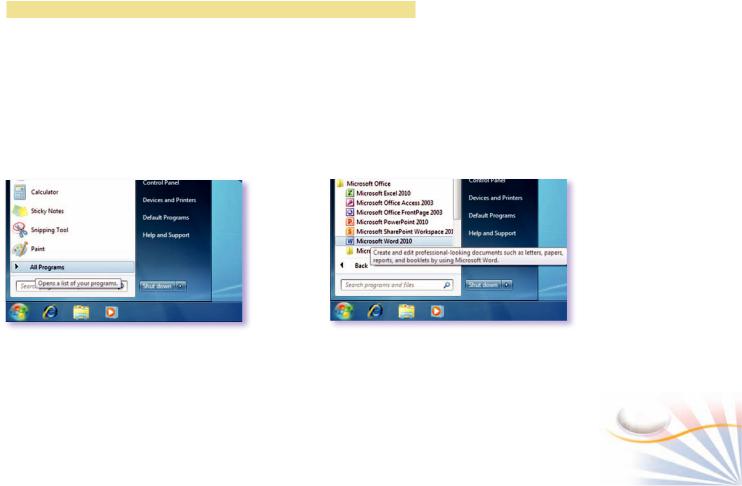
final printer-ready publication. If your page layout needs are a bit demanding for Word's tools, you can always transfer your Word document to a dedicated desktop publishing program to create the final layout.
Tables of numbers or other data: Clearly, Microsoft Excel is the tool of choice for working with numbers, and Microsoft Access for working with databases. However, Word tables can be used to store and display reasonable amounts of numeric or textual data. Word even provides mathematical functions for working with numbers in tables, as well as database tools for working with data fields and records in tables.
Why use Word for a task that can be performed with a more specialized software program, perhaps one which is already installed on your computer? The main reason is that you probably already know how to use Word, and the extra features of a more specialized program might not be worth the time required to learn a new software package, especially if you create only an occasional Web page, brochure, or other specialized document. You might also have existing Word documents that you can quickly convert to Web pages or other specialized formats. You can thus use Word to improve not only your current skills, but also your existing collection of documents.
Practice
Starting the Word Program
1.On the Windows taskbar, click the Start button at the bottom left corner of your screen.
2.Select All Programs and point to Microsoft Office.
3.Move the mouse pointer over and click on Microsoft Word 2010.
|
|
|
Starting the Word Program |
|
Starting the Word Program |
Getting Acquainted with Microsoft Word |
7 |
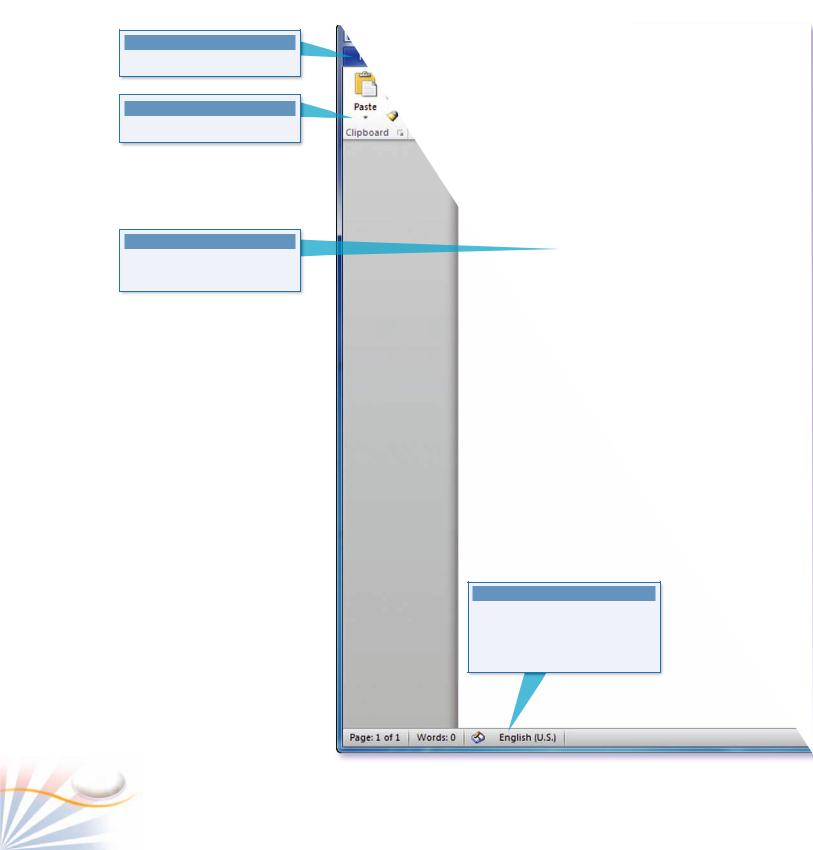
File Tab
opens document related tasks.
Ribbon
consists of a series of tabs.
Insertion Point (Cursor)
shows where the text will be written.
Word Window - General Overview
Status Bar
displays information about a command , an operation in progress, or the location of the insertion point.
8 |
Chapter 1 |
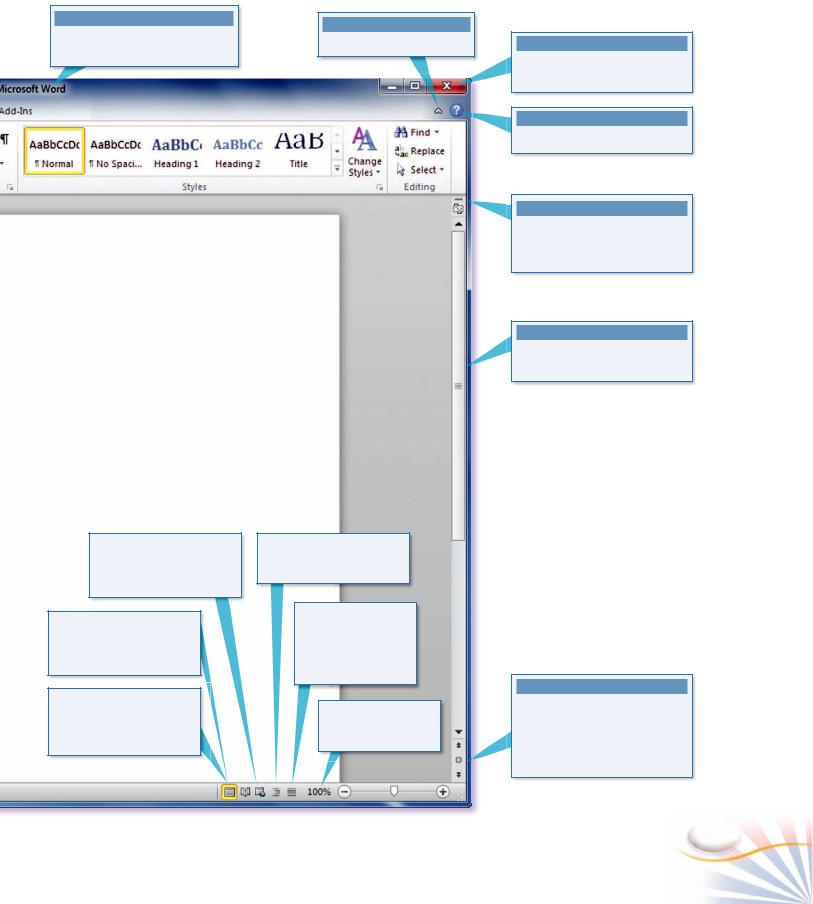
Title Bar
shows the name of the document and the program name.
The Web Layout view displays the document as it would appear in a web browser.
The Full Screen Reading view gives more space on the computer screen for reading documents.
The Print Layout is the default view of Word. Documents appear as it would be on a printed page.
Minimize the Ribbon
shows or hides the Ribbon.
The Outline view enables you to see the sections of a document text.
The Draft view essentially same as the Print Layout view but displays only the text in a document.
The Zoom slider lets you choose between zoom levels.
Minimize-Maximize-Close
closes or changes the Word program windows.
Help
shows help for the written text.
Split Box
allows you to work in two parts of your document at the same time
Scroll Bar
scroll to another part of the document.
Document Browser
lets you navigate through your document by letting you move between objects. To specify the type of object click the round circle and select the object.
Getting Acquainted with Microsoft Word |
9 |
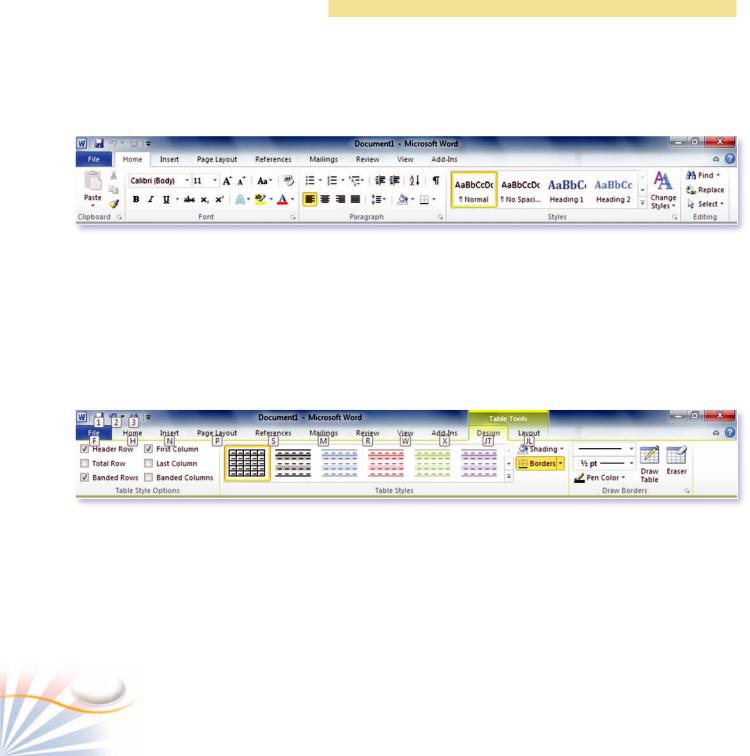
The Ribbon
The Ribbon is located at the top of the document area in Word. It consists of series of tabs.
Each tab is organized into groups and shows different commands.
Practice
To switch between tabs;
1.Click on each tab name.
Or use the turn scroll button of your mouse.
The Ribbon
The Ribbon is context sensitive. It changes depending on the selected tab, object or command.
For instance; when a table is selected, the Ribbon shows Contextual tabs related to tables.
The Ribbon showing contextual tabs with shortcut keys.
The diagonal arrows in the lower right corner of some groups open additional options relaeted to that group.
Each command on the Ribbon has its own shortcut keys. If you don't know to use which key to activate a command, press the Alt key on the keyboard to show Key Tips. Pressing the associated key on the keyboard activates the command.
10 |
Chapter 1 |
